
Pinkie House
Encyclopedia
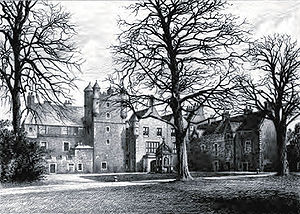
Tower house
A tower house is a particular type of stone structure, built for defensive purposes as well as habitation.-History:Tower houses began to appear in the Middle Ages, especially in mountain or limited access areas, in order to command and defend strategic points with reduced forces...
located in Musselburgh
Musselburgh
Musselburgh is the largest settlement in East Lothian, Scotland, on the coast of the Firth of Forth, six miles east of Edinburgh city centre.-History:...
, in East Lothian
East Lothian
East Lothian is one of the 32 council areas of Scotland, and a lieutenancy Area. It borders the City of Edinburgh, Scottish Borders and Midlothian. Its administrative centre is Haddington, although its largest town is Musselburgh....
, Scotland
Scotland
Scotland is a country that is part of the United Kingdom. Occupying the northern third of the island of Great Britain, it shares a border with England to the south and is bounded by the North Sea to the east, the Atlantic Ocean to the north and west, and the North Channel and Irish Sea to the...
. The house dates back to the sixteenth century, although it was substantially enlarged in the early 17th century, and has been altered several times since. Its location at grid reference is to the east of the town centre, on the south side of the High Street. The building now forms part of Loretto School
Loretto School
Loretto School is an independent school in Scotland, founded in 1827. The campus occupies in Musselburgh, near Edinburgh.-History:Loretto was founded by the Reverend Thomas Langhorne in 1827. Langhorne came from Crosby Ravensworth, near Kirkby Stephen. The school was later taken over by his son,...
, an independent boarding school. Pinkie House is not far from the site of the disastrous Battle of Pinkie Cleugh
Battle of Pinkie Cleugh
The Battle of Pinkie Cleugh, on the banks of the River Esk near Musselburgh, Scotland on 10 September 1547, was part of the War of the Rough Wooing. It was the last pitched battle between Scottish and English armies, and is seen as the first modern battle in the British Isles...
, fought in 1547.
History
Pinkie was formerly the country seat of the abbots of DunfermlineAbbot of Dunfermline
The Prior, then Abbot and then Commendator of Dunfermline was the head of the Benedictine monastic community of Dunfermline Abbey, Fife, Scotland. The abbey itself was founded in 1128 by King David I of Scotland, but was of earlier origin. King Máel Coluim mac Donnchada had founded a church there...
, and the tower house was built some time in the 16th century on the site of the Battle of Pinkie. In 1597, following the Reformation
Scottish Reformation
The Scottish Reformation was Scotland's formal break with the Papacy in 1560, and the events surrounding this. It was part of the wider European Protestant Reformation; and in Scotland's case culminated ecclesiastically in the re-establishment of the church along Reformed lines, and politically in...
, it passed to Alexander Seton
Alexander Seton, 1st Earl of Dunfermline
Alexander Seton, 1st Earl of Dunfermline was a Scottish lawyer, judge and politician. He was Lord President of the Court of Session from 1598 to 1604 and Lord Chancellor of Scotland from 1604 to 1622....
. He served as James VI's
James I of England
James VI and I was King of Scots as James VI from 24 July 1567 and King of England and Ireland as James I from the union of the English and Scottish crowns on 24 March 1603...
chancellor, and was created Earl of Dunfermline
Earl of Dunfermline
Earl of Dunfermline was a title in the Peerage of Scotland. It was created in 1605 for Alexander Seton, 1st Lord Fyvie, fourth son of George Seton, 7th Lord Seton . Seton had already been created Lord Fyvie in the Peerage of Scotland, in 1598, with remainder to his elder brother, John Seton...
in 1605.
The young Prince Charles, later Charles I
Charles I of England
Charles I was King of England, King of Scotland, and King of Ireland from 27 March 1625 until his execution in 1649. Charles engaged in a struggle for power with the Parliament of England, attempting to obtain royal revenue whilst Parliament sought to curb his Royal prerogative which Charles...
, lived here as a boy, after his father's move to London at the Union of the Crowns in 1603. He slept in what is still known as "The King's Room". In 1607 Seton married his third wife, Margaret Hay of Yester
Yester House
Yester House is an early 18th-century mansion near Gifford in East Lothian, Scotland. It was the home of the Hay family, later Marquesses of Tweeddale, from the 15th century until the 1970s. Construction of the present house began in 1699, and continued well into the 18th century in a series of...
, and from 1613 set about expanding the house, adding a long wing to the south, and decorating the interior:
- ALEXANDER SETONIUS VILLAM HORTOS ET HÆC SUBURBANA ÆDIFICIA FUNDAVIT EXSTRUXIT ORNAVIT … AMOENITATEM OMNIA AD CORDEM ANIMUMQUE HONESTE OBLECTANDUM COMPOSUIT
The Long Gallery is noted for its framed emblem
Emblem
An emblem is a pictorial image, abstract or representational, that epitomizes a concept — e.g., a moral truth, or an allegory — or that represents a person, such as a king or saint.-Distinction: emblem and symbol:...
s and inscriptions. When Ben Jonson
Ben Jonson
Benjamin Jonson was an English Renaissance dramatist, poet and actor. A contemporary of William Shakespeare, he is best known for his satirical plays, particularly Volpone, The Alchemist, and Bartholomew Fair, which are considered his best, and his lyric poems...
visited the house in 1619, he wrote to William Drummond of Hawthornden
William Drummond of Hawthornden
William Drummond , called "of Hawthornden", was a Scottish poet.-Life:Drummond was born at Hawthornden Castle, Midlothian. His father, John Drummond, was the first laird of Hawthornden; and his mother was Susannah Fowler, sister of William Fowler, poet and courtier...
to enquire after this emblems.
Seton also altered his northern property Fyvie Castle
Fyvie Castle
Fyvie Castle is a castle in the village of Fyvie, near Turriff in Aberdeenshire, Scotland.The earliest parts of Fyvie Castle date from the 13th century - some sources claim it was built in 1211 by William the Lion. Fyvie was the site of an open-air court held by Robert the Bruce, and Charles I...
before his death in 1622.
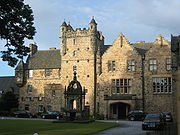
John Hay, 2nd Marquess of Tweeddale
John Hay, 2nd Marquess of Tweeddale was a Scottish nobleman.Hay was the eldest son of John Hay, 1st Marquess of Tweeddale and his wife, Jean, daughter of Walter Scott, 1st Earl of Buccleuch. In 1666, at Highgate in London, he married Lady Mary Maitland, daughter of John Maitland, 1st Duke of...
adding a door to the east front. In 1745, following victory at the Battle of Prestonpans
Battle of Prestonpans
The Battle of Prestonpans was the first significant conflict in the Jacobite Rising of 1745. The battle took place at 4 am on 21 September 1745. The Jacobite army loyal to James Francis Edward Stuart and led by his son Charles Edward Stuart defeated the government army loyal to the Hanoverian...
, Charles Edward Stuart
Charles Edward Stuart
Prince Charles Edward Louis John Casimir Sylvester Severino Maria Stuart commonly known as Bonnie Prince Charlie or The Young Pretender was the second Jacobite pretender to the thrones of Great Britain , and Ireland...
, the "Young Pretender", stayed here, as well as using the building as a field hospital. In 1778 the Hays sold the building to Archibald Hope of Craighall, who made further alterations, and added a stable block. Extensions were carried out in 1825, designed by William Burn
William Burn
William Burn was a Scottish architect, pioneer of the Scottish Baronial style.He was born in Edinburgh, the son of architect Robert Burn, and educated at the Royal High School. After training with the architect of the British Museum, Sir Robert Smirke, he returned to Edinburgh in 1812...
.
In 1951 Pinkie House was bought by Loretto School, and altered again in the 1970s, with the addition of two other buildings in the grounds. The south wing now serves as the headmaster's house.
Description
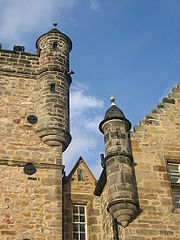
Bartizan
A bartizan or guerite is an overhanging, wall-mounted turret projecting from the walls of medieval fortifications from the early 14th century up to the 16th century. They protect a warder and enable him to see around him...
s and a crenellated parapet. This was attached to a strong three-storey main block with a pitched roof, again altered by Seton with square turrets. Inside there is a vaulted basement, and a wide turnpike stair up to the second storey. The interior has been modernised.
Seton's main addition was the long three-storey south wing, which includes on its upper floor the 96 foot Painted Gallery
Scottish Renaissance painted ceilings
A number of Scottish houses and castles built between 1540 and 1640 have painted ceilings. This is a distinctive national style, though there is common ground with similar work elsewhere, especially in France, Spain and Scandinavia. Most surviving examples are painted simply on the boards and...
. His mason may have been William Wallace
William Wallace
Sir William Wallace was a Scottish knight and landowner who became one of the main leaders during the Wars of Scottish Independence....
, although this attribution is only stylistic. On the south facade is a bay window
Bay window
A bay window is a window space projecting outward from the main walls of a building and forming a bay in a room, either square or polygonal in plan. The angles most commonly used on the inside corners of the bay are 90, 135 and 150 degrees. Bay windows are often associated with Victorian architecture...
, a feature new to Scotland in the early 17th century. The east facade is dominated by seven tall chimneys. There is a fine wooden ceiling, with classically-inspired paintings in tempera
Tempera
Tempera, also known as egg tempera, is a permanent fast-drying painting medium consisting of colored pigment mixed with a water-soluble binder medium . Tempera also refers to the paintings done in this medium. Tempera paintings are very long lasting, and examples from the 1st centuries AD still exist...
, in the long gallery, as well as many 17th century plaster ceilings. Another small painted ceiling was removed in 1951 and installed at the Huntly House
Museum of Edinburgh
The Museum of Edinburgh is a museum in Edinburgh, Scotland, depicting the town's origins, history and legends. Situated in the late 16th-century Huntly House on the Royal Mile, it is maintained by Edinburgh City Council.-External links:*...
museum in Edinburgh. Later interiors are by William Burn
William Burn
William Burn was a Scottish architect, pioneer of the Scottish Baronial style.He was born in Edinburgh, the son of architect Robert Burn, and educated at the Royal High School. After training with the architect of the British Museum, Sir Robert Smirke, he returned to Edinburgh in 1812...
.
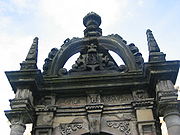
A walled garden lies to the east of the house, with a shelter, doocot, and sundial. There is a Renaissance fountain or draw-well in the corner of the L, to the west of the house. This heavily ornamented structure was built around 1610.
Tradition
The ghost of Alexander Seton's first wife, Lilias Drummond, is said to haunt the house, sometimes accompanied by a child, as a "Green Lady". She is also said to haunt Fyvie CastleFyvie Castle
Fyvie Castle is a castle in the village of Fyvie, near Turriff in Aberdeenshire, Scotland.The earliest parts of Fyvie Castle date from the 13th century - some sources claim it was built in 1211 by William the Lion. Fyvie was the site of an open-air court held by Robert the Bruce, and Charles I...
.
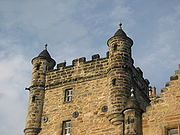
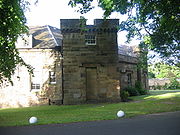
External links
- Loretto School: History of Pinkie House
- RCAHMS Images on-line, including a photograph of the painted ceiling.
- Gazetteer for Scotland: Pinkie House photograph page

